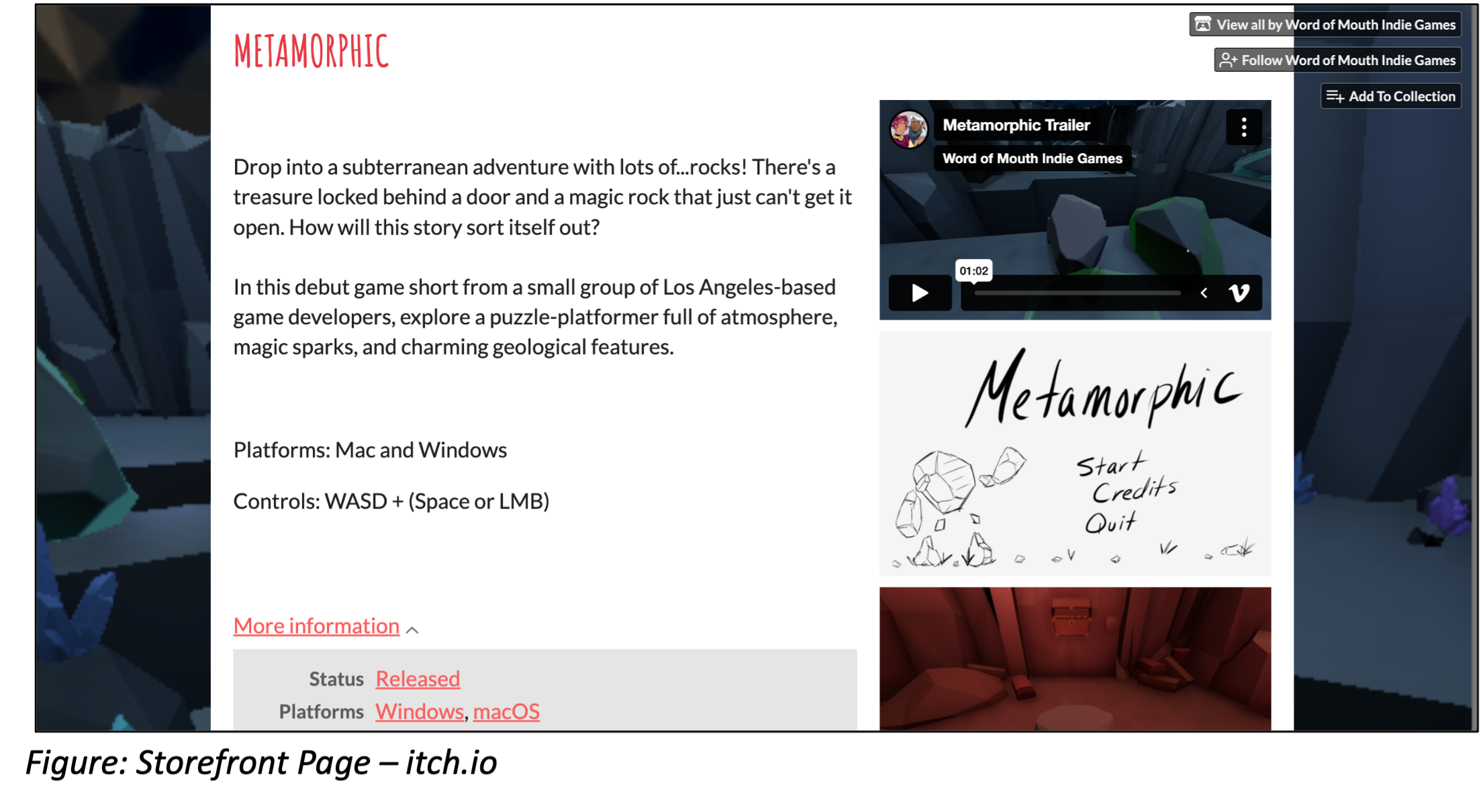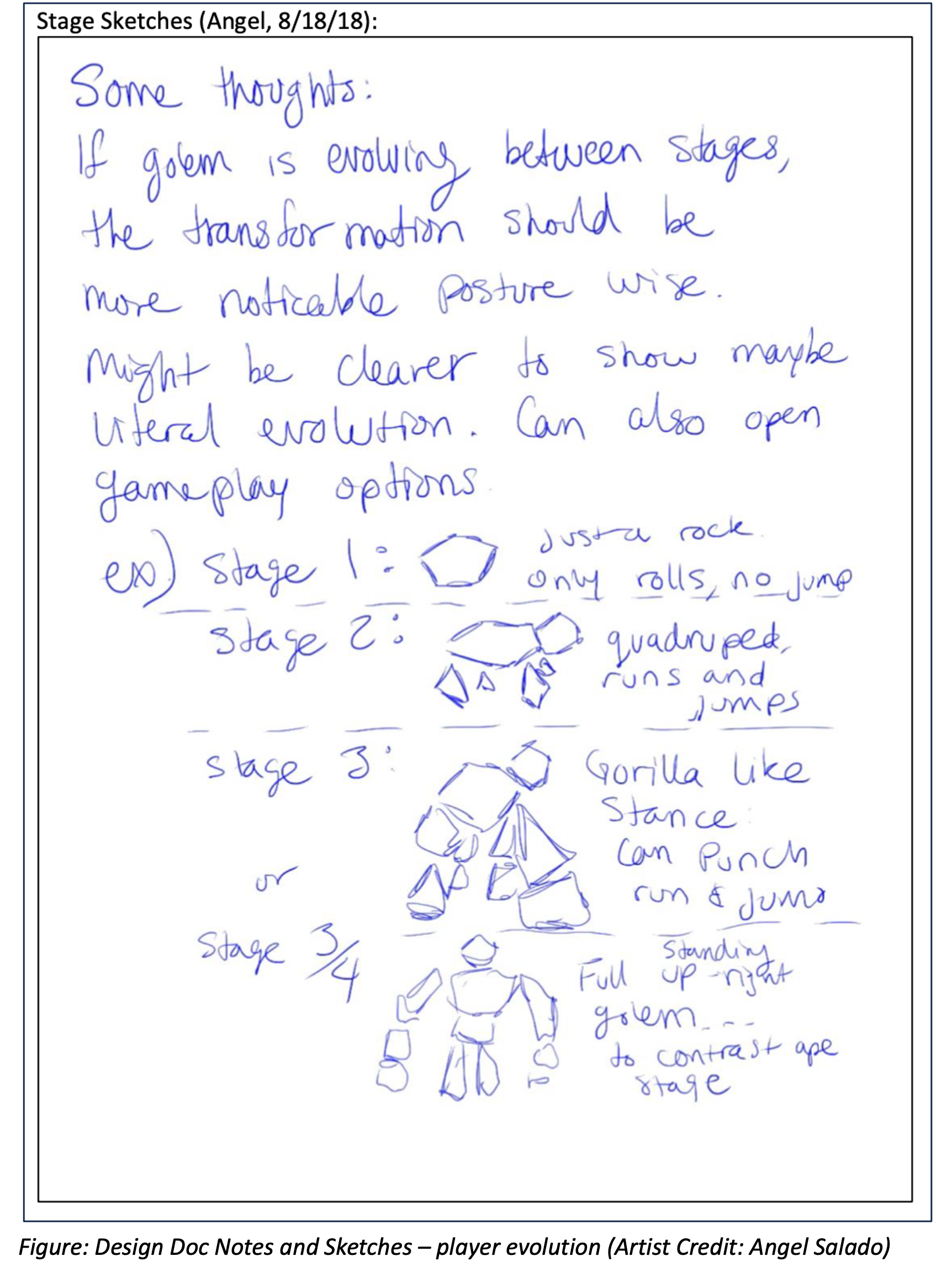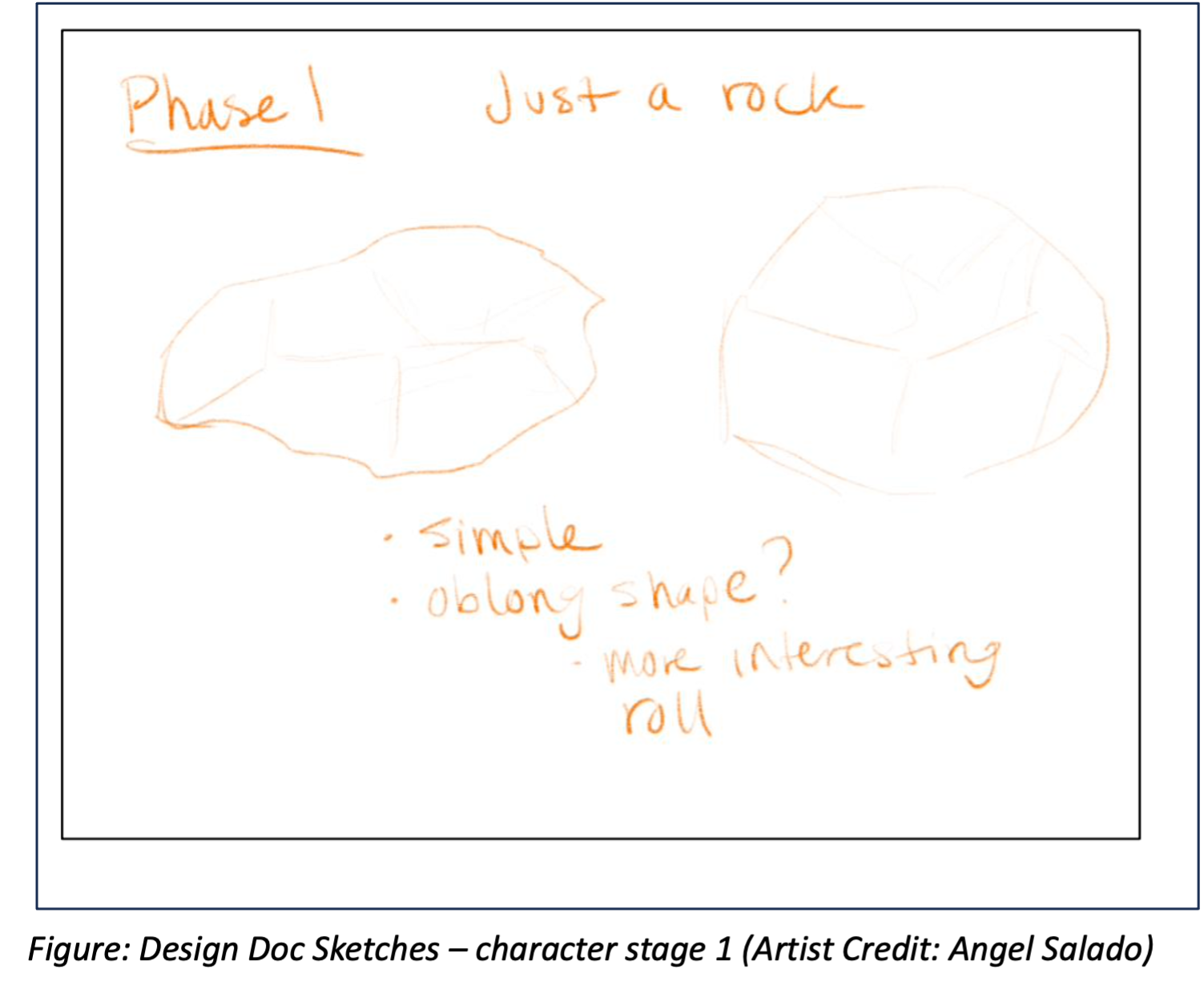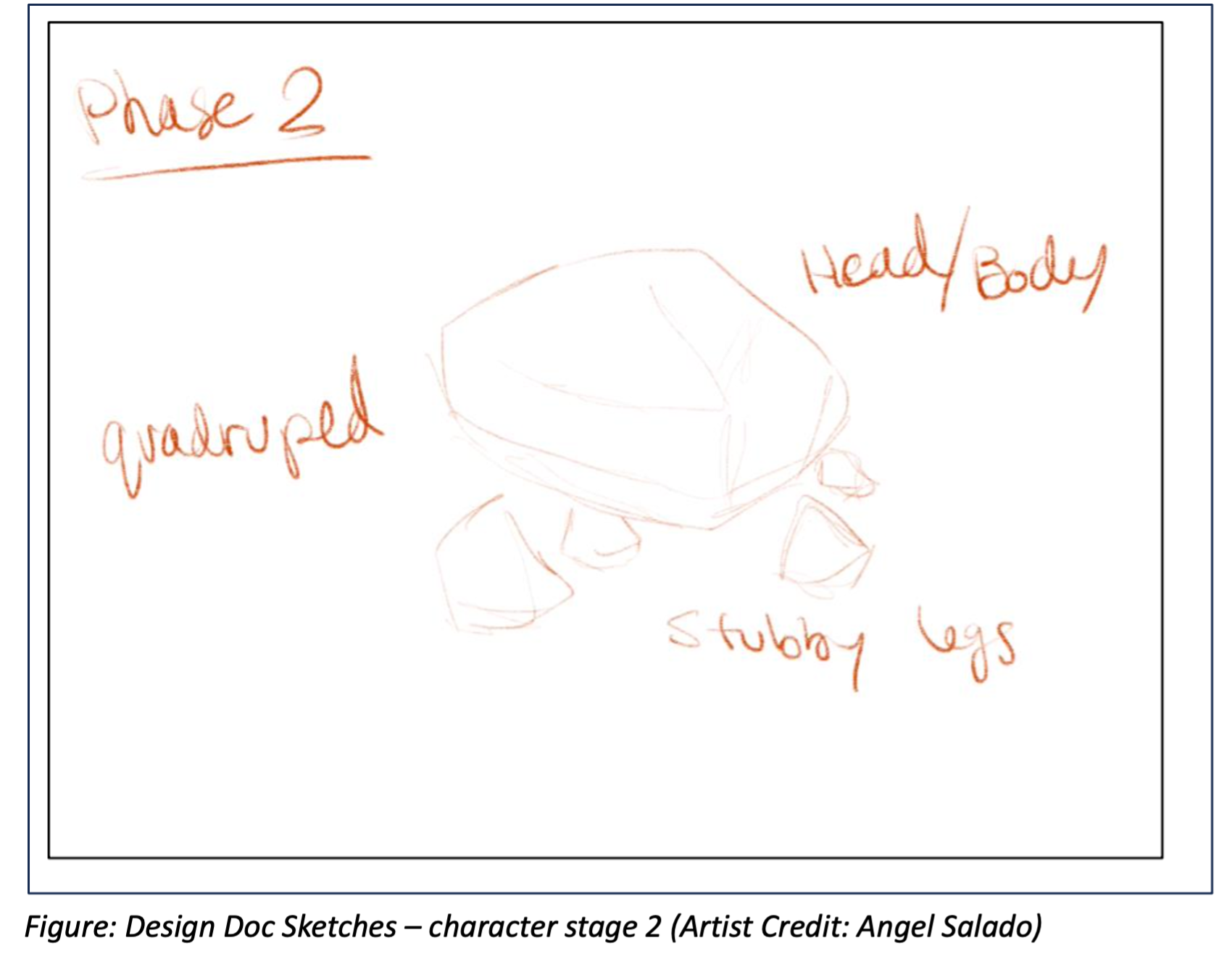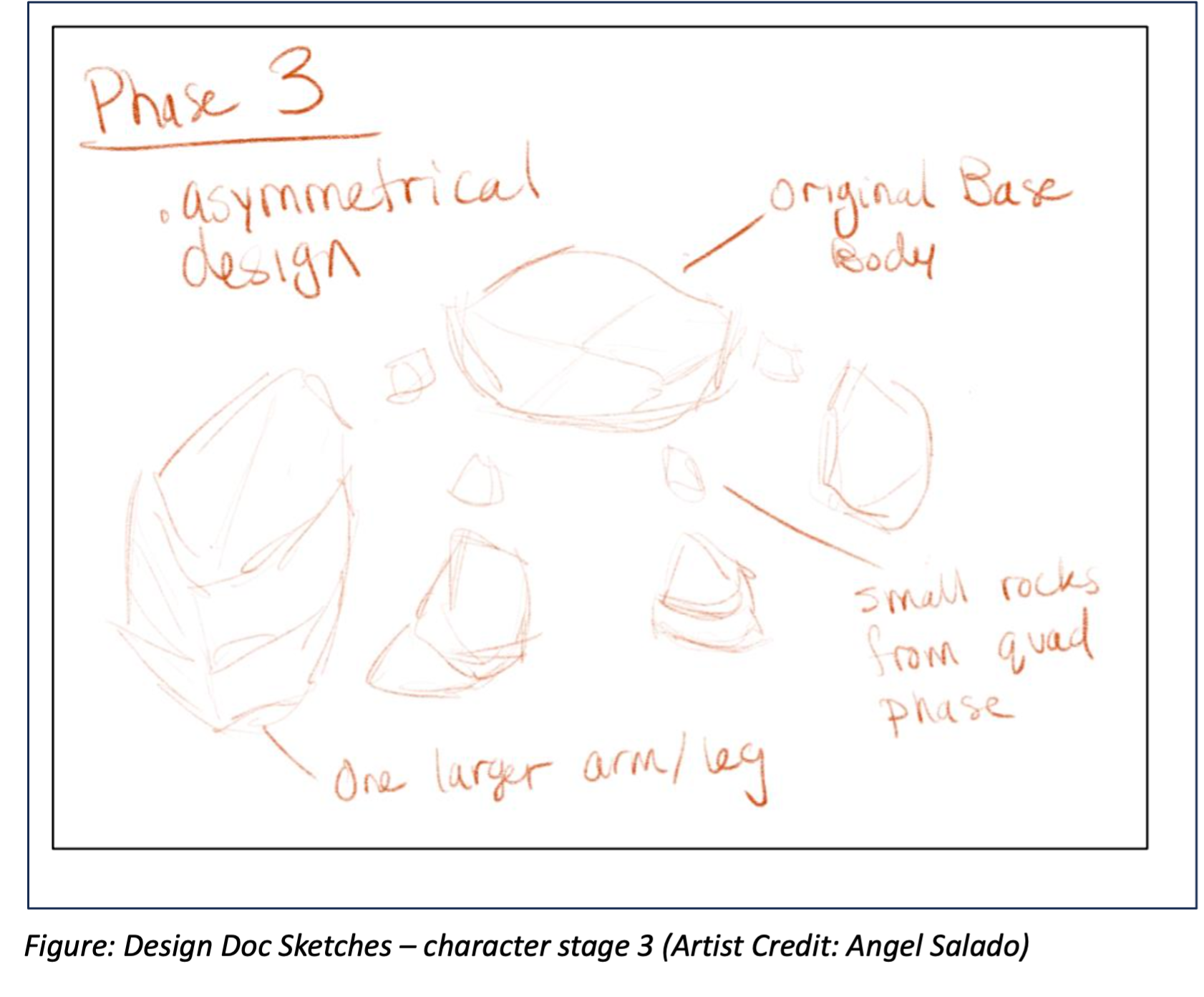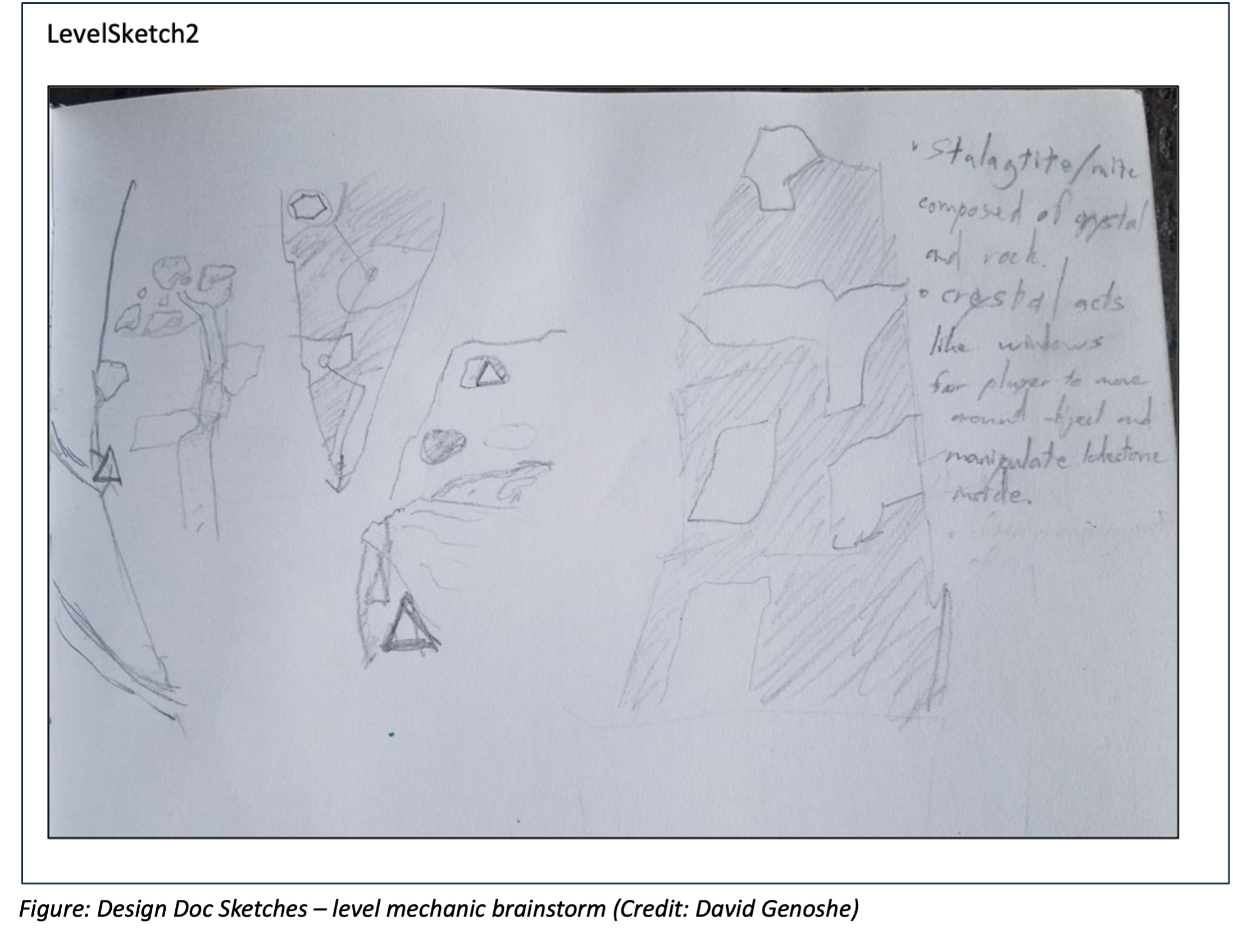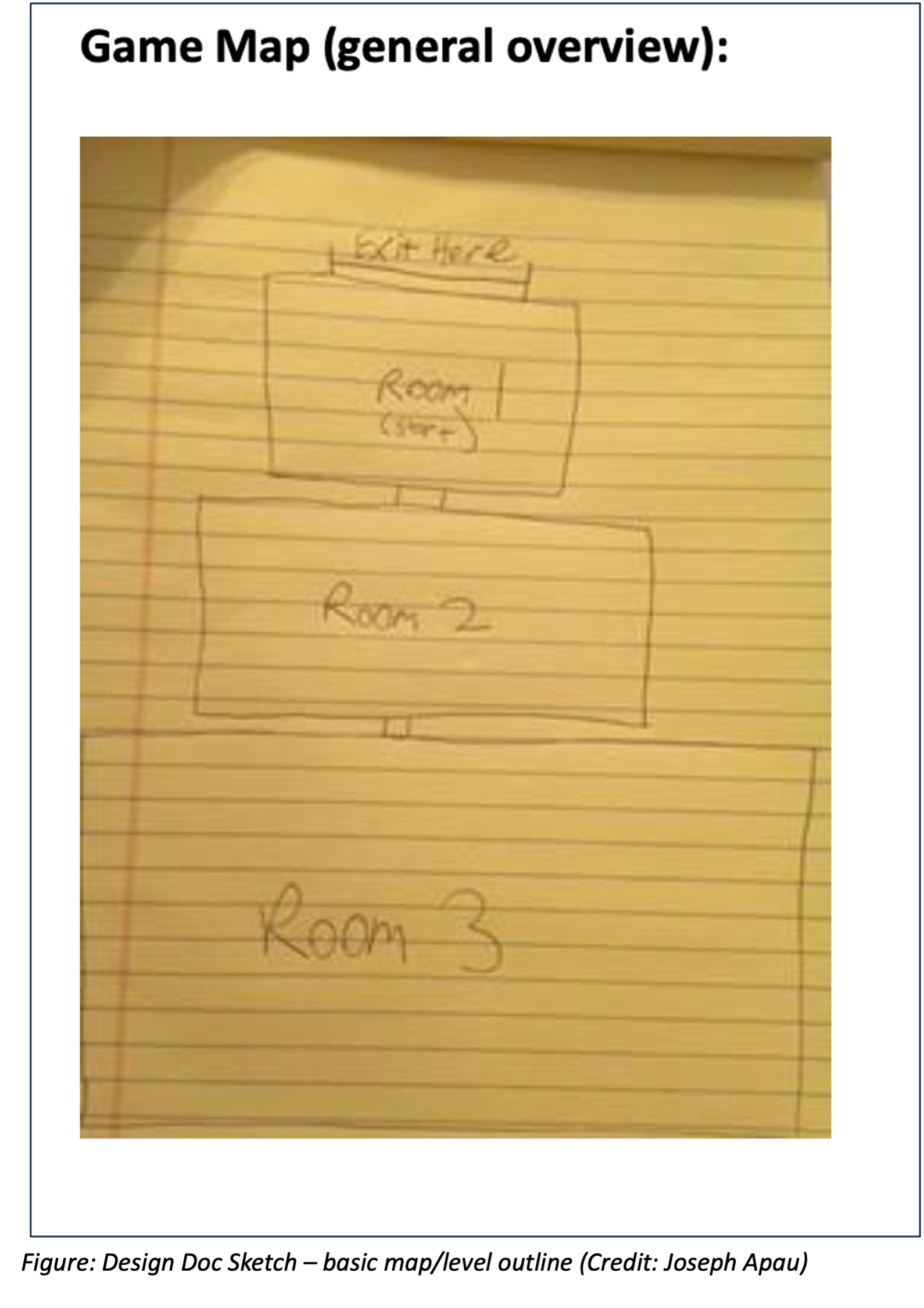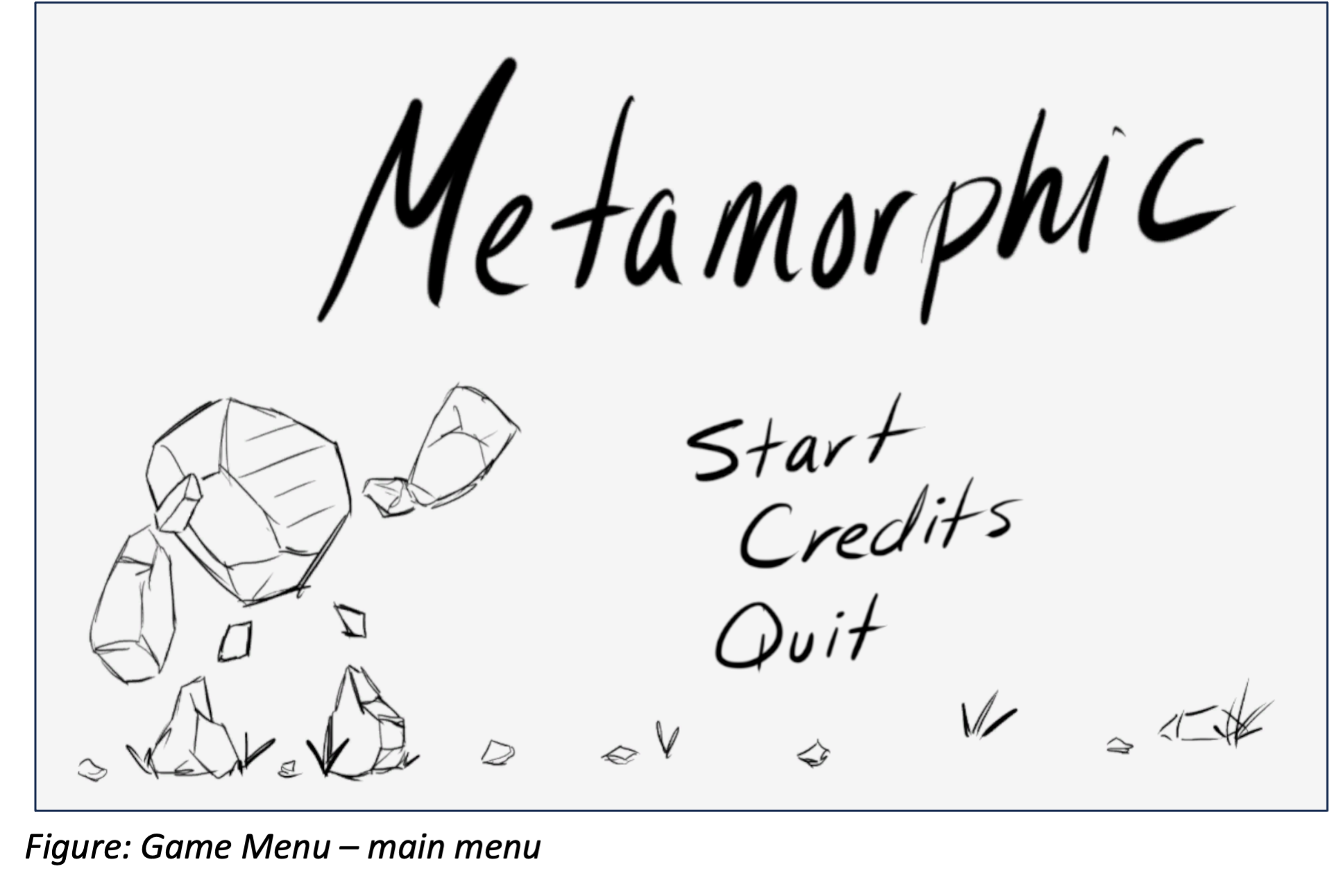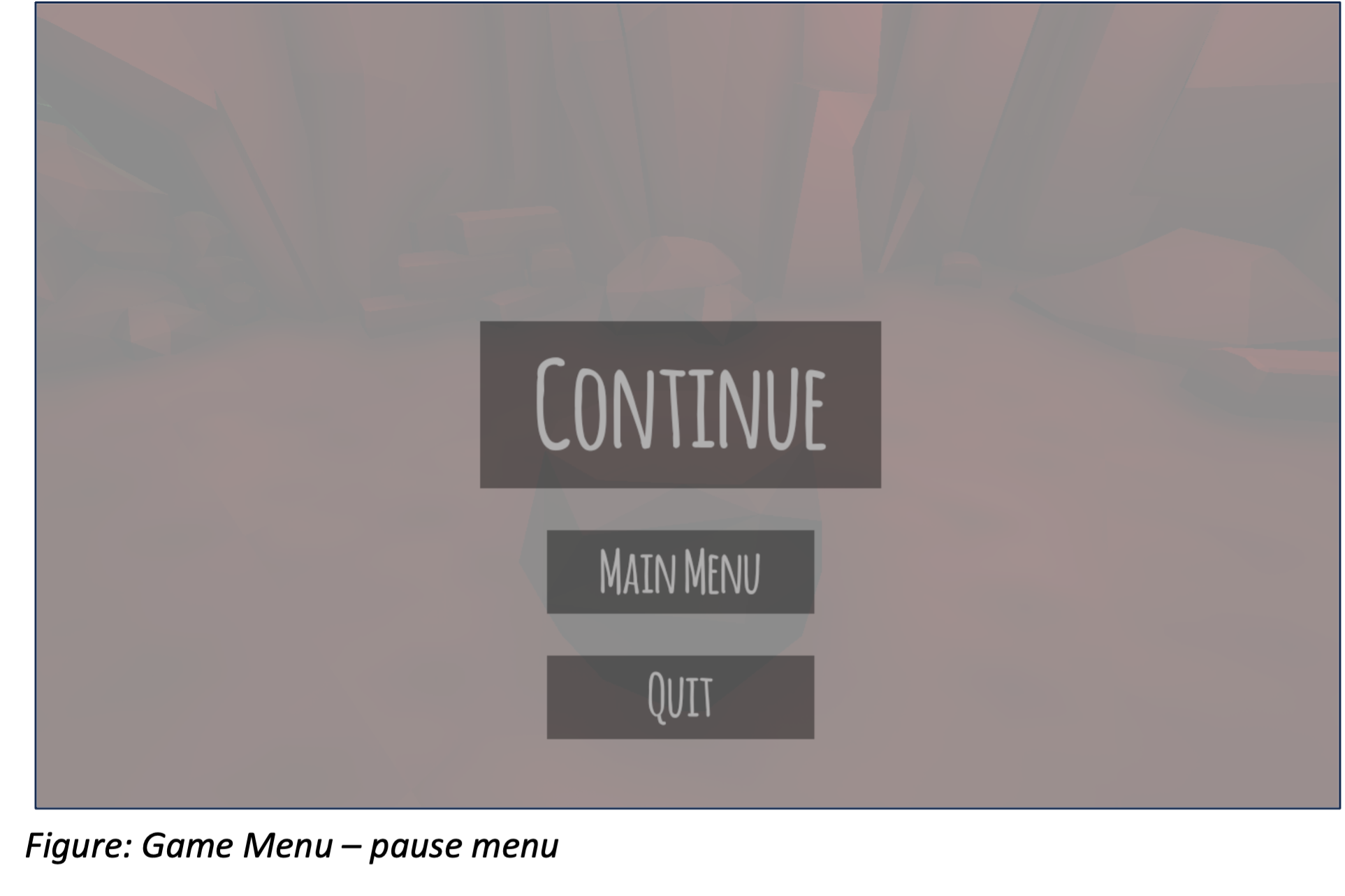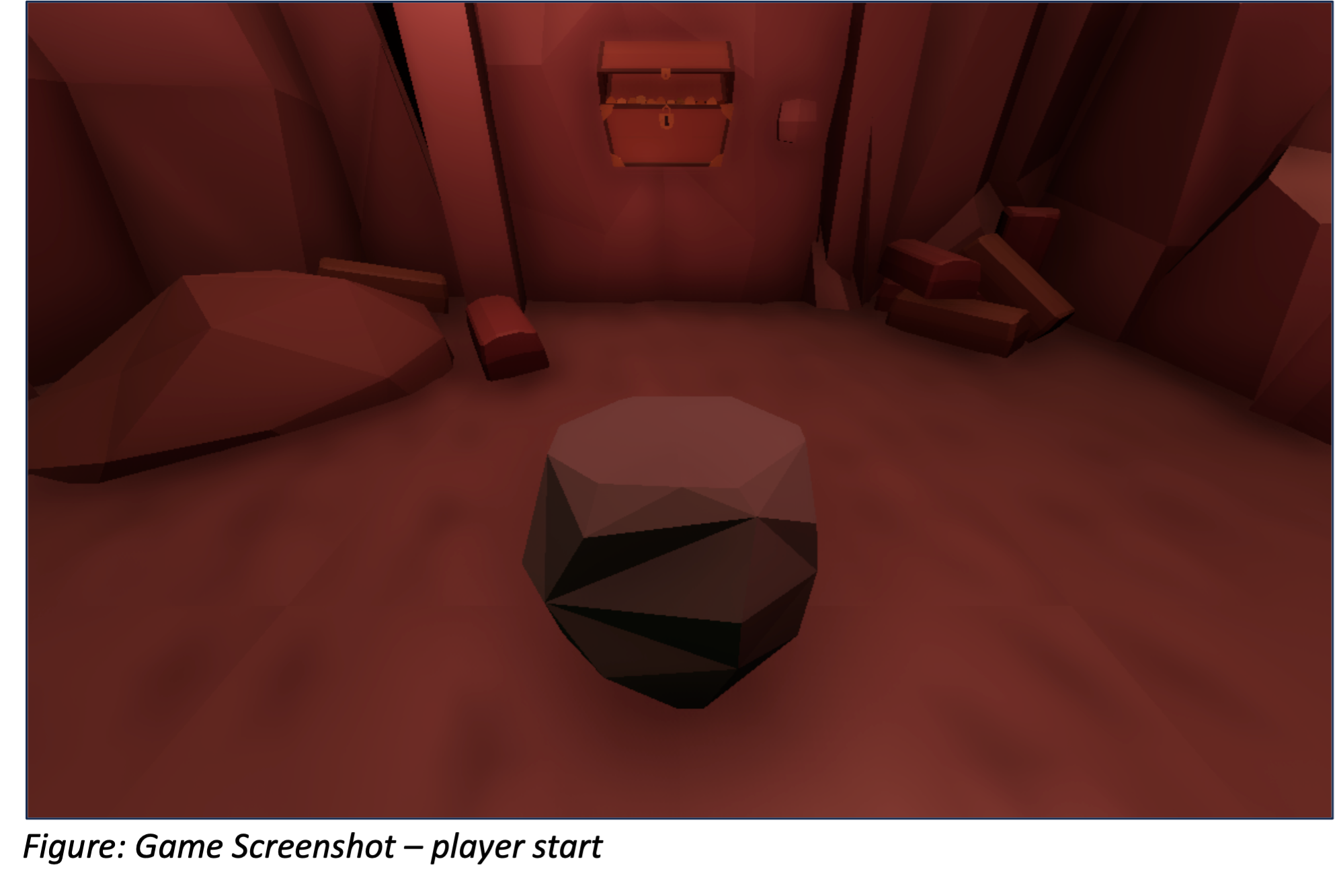Game Design:
Metamorphic
Game Design Overview
The Product
METAMORPHIC is a 3D puzzle platformer video game title about a sentient rock that moves around a subterranean-inspired environment. The main player-controlled character, named Roxanne, starts as a pebble and evolves into larger rock creatures as it attempts to open a large door, signifying the win condition. It features a complete game loop that can be completed in ten to twenty minutes, yet incorporates satisfying mechanics and storytelling that encourage replayability.
The trailer for this family-friendly title is shared below.
METAMORPHIC launched in December 2018 and its store page and playable file can be found here via itch.io.
Platform & Engine
This game was developed for PC using the Unity Game Engine. It was distributed on a prominent independent game store platform called itch.io for free.
Project Duration & Team Composition
This project spanned 3-4 months of work. It featured approximately 8 weeks of planning across different aspects of game production and design, followed by a game jam day of concentrated work. The game went through an additional 6 weeks of development within the Unity game engine as the team worked on iteration and polish.
The team behind the project was an independent group of six game developers spanning multiple disciplines: production, engineering, concept art, character art, 3D modeling, animation, audio and sound effects, level design, and UI design.
The final title was launched on December 8, 2018, on the itch.io online storefront.
The Goal
The goal of this game project was driven by the team’s desire to showcase their independent skills while delivering a fun, satisfying, and accessible game experience that delivered a strong narrative around a relatable character.
Role & Responsibilities
Producer, Designer, Engineer
My role within this project was severalfold. I led development as both the producer and the lead designer, while implementing all engineering aspects of the game and integration of features and assets within the Unity game engine using C# and the in-engine tools. I also crafted the narrative and designed the key player mechanic that tied into that player narrative. Outside of the mechanics and gameplay, I crafted the UX for menus and microcopy that appeared on various screens.
In a production capacity, I coordinated timelines for the team, helped formulate goals and milestones, and conducted testing and bug fixes. I also led marketing and distribution work as I wrote promotional copy and designed the online presence around the game product.
Game Design Snapshot:
Understanding the Audience
Who is the game for? What prior experience do they bring, if any? Within game design, the player is the one who will interact with the final product. Understanding that audience is key to making a game that provides a valuable player experience and satisfies player needs.
The Player: Overview
METAMORPHIC is a family-friendly title meant for players of all ages. It was created with PC players in mind who are used to playing other PC titles, and those looking for shorter, simpler titles to play in their spare time. While created for PC players who were familiar with PC controls, newcomers to PC games were also kept in mind as much as possible, with game mechanics and goals driven by player discovery and trial and error.
The Player: Pain Points
Pain Point: Search for engagement, fun, and excitement
Summary: Players look for entertainment first and foremost within a game. With so much choice of what to play, players may have a hard time finding the game that speaks to them, keeps them interested, and still feels fresh.
Goal: Create an immediately engaging experience with smooth gameplay, intriguing game mechanics, and appealing visuals.
Pain Point: Not being able to build skill mastery/invest in replayability
Summary: For frequent or prolific users of this type of media, it can be frustrating to not have a satisfying skill mastery journey or the option to apply that mastery to a title again and again through multiple playthroughs.
Goal: Provide a scaffolded, skill-building experience for players that gives them a sense of growth and mastery—and encourages further playthroughs.
Pain Point: Game mechanics not meshing with game narrative
Summary: Players can experience a sense of dissonance if the mechanics they are using in a game do not line up with the game or world narrative in place, often taking them out of the engaging and immersive experience they are looking for.
Goal: Align the gameplay mechanics with the story being told and create a satisfying interaction between the two.
Pain Point: Search for a shorter time commitment
Summary: With many choices of titles to play and demands on their time, players may find that some games ask for too much of their time or attention.
Goal: Allow players to interact with the full game experience in a short amount of time in a fun and energizing way, while navigating playable sections with clear beginnings and endings.
Goals & Limitations
The goals for creating a 3D puzzle platformer in this project were built around the limitations and restrictions involving time and resources, while still delivering a unique value proposition to players. Because of the technical requirements to make a satisfying product, the limitations defined what we could deliver to users while pushing the team’s creativity.
Restrictions & Limitations
The main restrictions around this project involved both time and resources. The timeline was built around two months of planning leading up to a “game jam” workshop day for the team to focus on assets and features in a group setting. Any further work past this would occur on a more independent basis.
Additionally, the disciplines represented on the team helped define the limitations of what the game could include. In total, the team represented the following aspects of game development:
Computer Programming/Engineering/Scripting
Project Management & Production
Concept art
Character art
3D modeling
Technical Art/Rigging
Animation
Narrative
Sound design (music, audio, and sound effects)
Level design
Graphic design
The main strengths out of all of these represented disciplines, and those focused on during ideation were the following: 3D art/3D modeling, sound design, narrative, and animation. These strengths, derived in part from thinking of the team’s restrictions and technical capability, led to clear features and value propositions for the game itself.
Features & Value Propositions
Tight, replayable game loop
Simple yet engaging story
Fun and relatable main character
Cohesive art style/direction
Bespoke art, assets, and scripting
Dynamic and satisfying animations
Clean and satisfying win-lose condition
Clear route to skill mastery
Game Design Process
METAMORPHIC as a game product began with planning, brainstorming, and ideation. After outlining the goals and values for this 3D puzzle-platformer, the team worked over 6-8 weeks to plan and iterate the design that we wanted to implement.
This design process featured paper sketches, scripting placeholders, concept art, and lo-fi prototyping (greyboxing) within the game engine. The overview below covers the various aspects of development that were iterated upon.
Player Experience
The player (of any age or skill) would begin with a simple main menu that includes a “Start” button that immediately brings them into the game. Initially, a short prelude animation/cinematic would start and show the player who they are (the pebble, Roxanne), and visually highlight the goal of the game—to exit through a large door with a treasure chest on it.
After understanding the goal of the game, the player can begin experimenting with the controls (WASD + Space bar) to see what they can do. The level/environmental design would inherently guide and challenge them from start to end as they use one key mechanic that they can learn about and master. This mechanic is simple and intuitive: drawing smaller rocks to themselves and pulling themselves to larger rocks.
The player’s key ability, triggered by the space bar, is signified by bright sparks pointed in a certain direction that imply a magnetic pull between the character and various objects. To exit the first small room, players must interact with and learn about this feature.
To progress, vivid cues such as glowing interactable rocks, key sound effects, and circles on the ground help guide the player toward intermediate goals of gathering rocks to help them evolve (see design doc clip below) and become larger.
More UX Considerations
From the main menu to the cut scenes to the visual effects around the player’s key ability, the player should be immersed in this world and feel like they are set up for success.
While the UX in this situation relies on the knowledge of using the WASD keys on a computer keyboard to move and a space bar to conduct special actions, everything else in the game itself is reinforced visually in the environment and level design as well as auditorily via sound cues and thematic changes in the background music.
In this way, a main UX consideration from a design perspective was creating a holistic and cohesive experience that challenges the player from a game perspective and provides satisfying milestones for them to achieve.
Story/Narrative
The story for METAMORPHIC begins with a simple, inorganic rock. The team affectionately called this character Roxanne. The ideas for this story began with the character (a type of character that would be more achievable to rig and animate with our limited resources) and we expanded upon this to flesh out the full narrative and game features.
The narrative is summarized below:
Roxanne, a simple pebble in a cavern-like environment, is struck by lightning. This event causes Roxanne to come alive and exhibit a spark-like ability, perhaps magnetism that allows it to pull smaller rocks to itself and pull itself to larger rocks.
Upon awaking, Roxanne notices that they are in a room with a large door featuring a treasure chest icon on it, but they are too small to interact with the door in any way. Looking around, they find that while they cannot go through the door, they can pull away some rubble to go exploring nearby in an adjacent cavern-like room. Perhaps to find a way to get through the treasure door that blocks their way.
As they move into the next room and the room beyond that, they use their powers to pull smaller rocks together and morph into a larger, more evolved rock form, until eventually, they are a large golem-like creature that can return to the starting room and open the door to treasure successfully.
This is where the player leaves Roxanne, as they head off into the great unknown.
Character Design & Character Animation
The character Roxanne, as mentioned above, was one of the first key pieces of the design process. The idea to use an inorganic creature was appealing because of our limited ability to rig complex characters, and the desire to make an entirely cohesive bespoke game product from scratch.
Through team discussion, the character of Roxanne came to life. It would begin as a simple pebble, evolve into a medium-sized rock creature, and eventually become a large, strong figure that could overcome any obstacles in its path.
Our concept artist and animator, Angel, brought several important elements to this character’s design that helped define who they became. These elements were informed by his history as an artist and animator—and the one who would be animating the character itself:
Posture changes as Roxanne evolves (rolling to quadruped to biped)
Asymmetry and oblong shapes to create interest and a unique visual silhouette
Lopsided gate or uneven roll to create a more natural, engaging movement
Level Design
The level design for METAMORPHIC was iterated on several times as the team discussed scale and complexity. Certain decisions were made for the sake of practicality that impacted gameplay and level design:
restrict movement to one horizontal plane,
limit scope to three rooms to allow for environmental design, and
use an indoor setting to limit extra visual loads imposed by an open setting.
Initially, three-dimensional movement and mechanics involving stalagmites/stalactites were brainstormed (see below), but they both proved to be impractical. This realization led us to focus on movement in only one plane, but also helped encourage creative level design decisions.
The level design resulted in a three-room setup, with each room becoming progressively larger and with slightly more complex puzzles that built upon success and mastery in the preceding rooms. Main obstacles to success in each room were navigating a rocky environment with blocked views and avoiding falling into the ravines in the ground that would cause a “game over” state.
In each room, the player would need to navigate the level to collect the smaller rocks required to evolve and bring them back to the evolution circle, where they could become a larger rock creature.
Once the player completed the final evolution in the third room, they would then trigger a sequence that would show them running and breaking through the walls all the way back to the first room, where they first began as a pebble. They could then open the door with the treasure icon that thwarted them in the past and venture forth to see what lies beyond.
Environmental Art
After the level design was settled in broad strokes, the environmental art was the next priority. The environment team, composed of two members working together, came up with the idea to have the art style progress between rooms to help indicate player achievement and narrative progression.
Cavern art style (room progression)
Room 1: Red, dusty, desert-like rocks
Room 2: Mossy, jungle-like, gray rocks
Room 3: crystalline, blue rocks
Additional style and asset guidelines were used to create consistent art direction, textures, and lighting.
Style and asset notes
Solid color textures
Light and color to create mood
Light coming from above
Black vignettes and play of light/dark to give the illusion of more space/depth
Interactive rocks to have a metallic sheen and potentially particle effects to act as visual cues
Library of rock clusters and walls that can be placed for variety
Sound Design
The sound design decisions were grouped into two categories: music and sound effects (SFX). The implementation of sound effects would be influenced by scale and the size of objects/assets and would be impacted heavily as a downstream discipline in the game development pipeline. These considerations had to be kept in mind as the game was being developed, but planning happened early on so that sound design features could be integrated as cleanly as possible in the end stages.
Music
The music would evolve along with the environmental art and art direction in each room to signify player achievement and narrative progression. There would also be music on the main menu as players opened up the game. These goals were translated to five key musical assets that the team wanted for the final product:
room 1 musical theme
room 2 musical theme
room 3 musical theme
walking back sequence musical theme
main menu music (main theme based on in-game theme)
Sound Effects/SFX
Sound effects are a major feature of a full game experience based on the current game market. They help communicate actions and create a holistic experience for the player as they move around the game world and progress the story. The planning stage for SFX was important as the team needed a list of sound assets that were accounted for as early as possible.
The list for sound effects included the following and covered both 3D actions and UI interactions:
menu sounds
mouse click
mouse hover
walking for characters of different sizes
different material sounds
size-based sounds
holding rock
dropping rock
pulling self to rock
rock colliding with the player varies based on size
player colliding with a rock varies based on size
evolution sound
wall breaking
door handle turning
door opening
UI/Menu Design
The UI design for this game title was kept simple and clean to get players started as soon as possible. It would feature bespoke menu art, include only a few menu options (start, credits, quit), and be easy to navigate.
Player Feedback
Due to the constraints in this project, there was not an extended player testing phase of any kind. However, the team noted feedback and observed user interactions when possible to help us develop a better product.
Early Stage Feedback
In a key playtest that our team was able to conduct early, we observed a player who didn’t have much experience with games at all. However, this participant was able to navigate the stages and mechanics roughly as expected, which was great to see, and there were moments of ingenuity when they solved problems in unexpected ways. This showcased how players may have more ways to interact with the product than we originally planned for.
One important pain point that we discovered in this process was that the rocks that the player was supposed to interact with (rocks to pull to the player, or rocks for the player to gravitate toward) were not highlighted enough in the environment. The art direction was shifted afterward to be less subtle around these effects. This resulted in easily visible and recognizable rocks with a high shine and textures with an eye-catching animation sequence.
Late Stage Feedback
As the game became more polished, the near-final product was shared with family and friends. This served as a last-minute round of player feedback as the game was being put online and distributed. This feedback resulted in a few important findings:
1. A game bug could lead to accidentally winning the game at the start
In one important quality assurance finding, a team member’s brother went straight for the door as a pebble and was able to accidentally trigger the win condition and final cutscene. This was an easy bug fix to implement in-game, but highlighted how such a complex digital product can have large bugs or unintended player interactions.
2. The game was engaging was fun for younger audiences
Additionally, proving that we had made a family-friendly product that provided an engaging, replayable experience, another team member relayed that their younger cousins, around 5 to 10 years of age, greatly enjoyed the puzzle and kept playing the game over and over again as they gained mastery over the game loop and mechanics.
3. Player movement and player collision didn’t always feel satisfying
One final piece of player feedback that came after ship—but is worth mentioning—was a comment about how the player collision and movement did not always feel as smooth as the player wanted it to be. Thinking about the design, this would most likely be addressed after further playtests as a two-part solution that both expanded the traversable paths and tweaked the collision volume or movement logic around the player. This was noted for future learnings/takeaways.
Shipped Product
METAMORPHIC shipped as a final product on December 8, 2018. This independent game is a complete digital product that was distributed on the itch.io online storefront for free to any PC user. Created for the computer platform, METAMORPHIC was made available to be played on both Mac and PC, accommodating any standard screen resolution.
From opening splash screens and a main menu to a full narrative-rich gameplay loop, METAMORPHIC delivered the product that the team had envisioned: a fun, engaging, and imaginative game experience about a small rock that works hard to become bigger to achieve its goals. It was extremely satisfying for everyone to see the final product and to play the game itself while seeing how everyone’s contributions and specialties made this game complete and successful.
Gameplay & Narrative Summary
The METAMORPHIC gameplay and narrative both centered around the idea of an animated rock that both wanted to achieve a goal (walking through a large door to treasure) and was granted a magnetism-themed ability (to zap environmental rocks, pulling them to it if the object was smaller or being pulled to it if those objects were larger). This gameplay successfully provided a puzzle/skill mechanic as well as a traversal technique around the environment.
Narratively, this gave the player a satisfying experience around collecting rocks to then evolve into a larger rock being that fit the story of Roxanne’s character and goals. It also helped create a dynamic environment where interactions with different pieces of it changed over time in an organic and logical way.
The evolution of the main character over time was also built on the player’s actions, as the game visually added more and more rocks to the player model in a narratively cohesive way.
UX/Player Experience Highlights
Camera Movement
The player was able to have a clean and straightforward experience built around a third-person dynamic camera that allowed them to see both the character and the environment they were moving in. This third-person perspective meant that the gameplay mechanics were also in plain sight, and the actions the player took were always intuitive, understandable, and easy to build upon.
When shifting between player-controlled moments and camera-controlled moments, it was also important to the team that this switch felt straightforward and natural. Whenever this happened, the camera took over from wherever the player had it situated to perform some scripted action. Control then fell back into player control following the animation. This extra work around camera transitions helped provide a clean and compelling user experience.
Animations, Visual Effects, Sound Effects
As a visual and auditory medium, video games leverage character animations, environmental/prop animations, sound, and visual effects to provide meaningful player feedback.
To that end, METAMORPHIC included player animations that evolved with the character model—idling/rolling/walking, triggering key abilities, and triggering evolution sequences. Evolutions were large moments within the game that featured additional large visual effects and audio cues to signify the importance of the moment.
Interactive sound design, like that surrounding the evolution sequences, helped round out the player experience. Key actions such as picking up or dropping objects, or simply walking/rolling, were reinforced with auditory cues that both made sense within the narrative and environment and highlighted the importance of different actions to the player as they were taken.
Menus, Microcopy, UI
The UX writing and UI design for this game were clean and simple. The title screen/main screen evoked a sense of whimsy by highlighting the title and character of Roxanne. It also provided clear options for how to proceed (i.e., the choice to start, see the credits, or quit). We kept word choice and microcopy to only one or two words here.
Within the game itself, the pause menu could be accessed by pressing the Escape key and similarly featured an intuitive and simple user experience with buttons that could quit the game directly, take the player back to the home screen, or return to the game. Word count was kept at a minimum here as well.
Team Credits
The team of independent game developers, operating under the moniker of Word of Mouth Indie Games at the time, was credited in full within the product by name/role through a traditional rolling credits sequence.
Distribution
The game was packaged and delivered to PC players on the indie game storefront itch.io and offered for free to players. The store page featured a trailer, screenshots, promotional/marketing copy, and instructions for how to download and play the game.
Learnings & Takeaways
The team saw METAMORPHIC as a successful product created through an immense amount of effort. It showcased the team’s specialties while delivering a user experience to players that was fun and engaging for people of all ages and experience levels.
In retrospect, there were several key wins and product pain points that we learned from and that provided value to future products we designed or developed.
Product Wins
One of the key wins of this project was the successful integration of so many disciplines, from art and sound to design and engineering. Leveraging the team’s strengths and navigating the limitations in place, we were able to deliver a strong player experience that was built from the ground up with them in mind.
Specifically, the character, story, environment, and mechanics were all woven together in a consistent and compelling way to bring players immediately into the game experience they were looking for. With little investment or prior knowledge, players of all ages and experience could engage with a fresh new product that they could master and come back to again and again. It was immersive and fun, while reinforcing a small but satisfying entertainment experience.
Product Pain Points
Looking back at the final product and user feedback, there were three key pain points that arose despite the overall satisfaction the team had with the project.
Product Pain Point #1:
The first point of friction was that we hadn’t coded a way to skip the intro sequence and cutscene for those players who already saw it. That meant that if they did replay the game, they were delayed from reentering the game as fast as they wanted to. More importantly, if players fell off the map (the only way to hit a fail condition), then they would restart the game and have to watch the full intro sequence as well, which took the player out of a cohesive experience. This was a large pain point and would be a priority to address. One fix would be to allow players to skip this introduction sequence at any point.
Product Pain Point #2:
A secondary pain point that came up—that would be hard to solve and require further user testing and play tests—was that the player collision and physics could sometimes be jarring or unpredictable. Research would be required to make a smoother traversal experience that could interact more smoothly with the environment. Initial ideas the team had would involve enlarging the environment and paths themselves to allow more space between the player character and the walls they may walk into, as well as tweaking how the player reacted to physics collisions.
Product Pain Point #3:
Accessibility would also be a pain point moving forward. We knew that given more time or resources, user accessibility could be improved, and as a part of that, a full options menu would be ideal. This could allow users the option to turn on visual indicators or subtitles for auditory cues, enable color schemes for anyone who needs contrast options, and choose alternate control options for those who prefer to use something other than a mouse and keyboard.
Future Design Work
Looking at this now from both game design and UX perspectives, there are several considerations and aspects I would like to bring to future projects:
Refining the design
While we didn’t have time in this project, I would want to have more rounds of testing and refinement to address as many user pain points as possible.
Team process
Overall, the team process was successful, but could have been staggered and extended with more time. Instead of one planning stage that led to a game jam, followed by a lot of independent work, I would shift to working in two or three design sprints that we could iterate on in between.
Player controls and onboarding
An onboarding experience wasn’t specifically built into this project’s scope, but I think it would be great to include. In this project, that could have included simple UI text that showed controls or been communicated through video tutorials within the game. An additional controls explanation through the options menu would also be useful.
Player pace and skip options
As mentioned above, I think it’s important to integrate ways for users to go through a product at their own pace. I would want to provide ways to bypass scripted actions if they wanted to, or otherwise let them skip portions (if they so choose) without impacting their ability to interact with the core product.
Accessibility options
Implementing accessibility options in future products allows for an inclusive user experience. This could be done in many ways: volume controls, closed captions/subtitles even when there isn’t spoken dialogue, high contrast options for colors used within the game, etc.
In conclusion, this family-friendly 3D puzzle platformer delivered the player experience that we were looking for as an independent development team—while still giving us a lot of learning about how to make an even better experience possible in the future.



